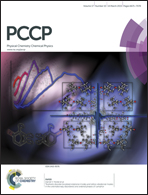Interactions of carbon nanotubes with the nitromethane–water mixture governing selective adsorption of energetic molecules from aqueous solution†
Abstract
The structure and dynamics of the nitromethane–water (NM–WT) binary mixture surrounding single walled carbon nanotubes (SWNTs) have been investigated by molecular dynamics simulations. The simulation trajectories show that the NM molecules can be selectively adsorbed both outside the surface and inside the cavity of SWNTs mainly dominated by van der Waals attractions because SWNTs have a higher binding affinity for NM than WT. The binding energies of SWNTs with NM and WT obtained from electronic structure calculations at the M06-2X/6-31+G* level are 15.31 and 5.51 kcal mol−1, respectively. Compared with the SWNT exterior, the selective adsorption of NM is preferentially occurred in the SWNT interior due to the hydrophobic interactions and the dipole–dipole interactions, which induces the decrease of the hydrogen-bond number of NM with WT and ordered structures of NM with preferred intermolecular orientation in the SWNT cavity. Furthermore, the selective adsorption dynamics of NM from the aqueous solution is regardless of the chirality and radius of SWNTs. The SWNT radius plays a negligible role in the mass density distributions of NM outside the SWNTs, while the mass density of NM in the SWNT interior decreases gradually as the SWNT radius increases. The structural arrangements and intermolecular orientations of NM in the SWNT cavity are greatly dependent on the SWNT radius due to the size effect.


 Please wait while we load your content...
Please wait while we load your content...